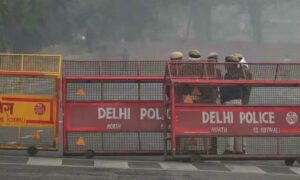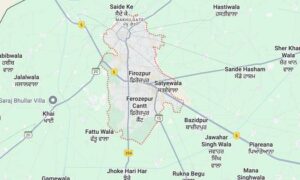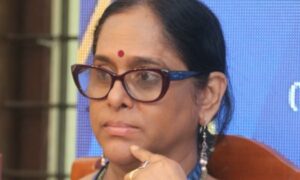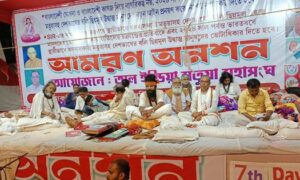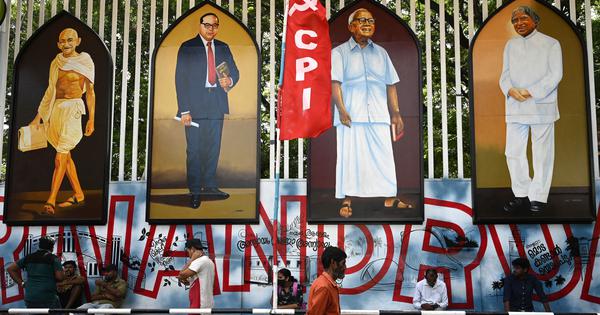
My Lord, since you have banished poverty
From this fair land, I feel it is my duty
To lay an information that the outlaw
Has taken refuge in my humble home.– Anonymous Sanskrit Poet
That ancient verse echoes with painful modern irony. Authorities then and now announce poverty vanquished; yet the outlaw continues to find refuge in the humblest of homes.
The debate
Kerala is now amid a heated debate after Chief Minister Pinarayi Vijayan declared that the state has eradicated extreme poverty. This announcement marks the culmination of the Extreme Poverty Eradication Programme launched in 2021. The journey to this claim is detailed in the state’s Government Economic Review of 2024.
The review outlines a meticulous, bottom-up process. It began in 2021 with a draft list of 118,309 households. This was gradually refined through local-level verification to identify 64,006 families, encompassing 103,099 individuals, as athidaridrar – the extremely poor.
These families were assessed based on four often-overlapping deprivation categories: food, health, income, and housing. The state’s Poverty Eradication Mission, called Kudumbashree Mission, then developed individualised micro-plans for each family.
By leveraging various government departments and specific schemes,, the government by October 2023 claimed that 48% of these families had been lifted out of poverty, emboldening it to announce the full eradication of extreme poverty by November 1, 2025.
While the government celebrates this as a historic milestone, critics argue the definition and measurement used for this exercise are conceptually weak. The Minister for Local Self-Government dismissed concerns expressed from a group of 30 civil society members as “politically motivated” and from “so-called experts”. (I was among that group.)
Having watched and participated in Kerala’s development, especially through my work with artisanal fisherfolk in the 1970s, whom I long ago described as “outliers” to the celebrated Kerala Model, I believe this moment requires not partisan triumphalism but conceptual clarity and historical perspective, not to speak of a measure of modesty and humility.
This article traces that history, clarifies my view of poverty as a relationship and critiques recent analyses of this sweeping claim.
Historical lens
The current debate cannot be understood without recalling a pivotal moment in the 1970s that forced a fundamental rethinking of how poverty was measured in Kerala.
In 1971, the seminal all-India poverty study by eminent economists Dandekar and Rath, based on National Sample Survey data, delivered a startling verdict: Kerala was among the poorest states in India. For anyone living here, this diagnosis was nonsensical.
The state displayed no signs of famine-like deprivation. Researchers at the Centre for Development Studies in Thiruvananthapuram, led by the visionary economist KN Raj, identified the flaw: the National Sample Survey methodology assumed that nutrition was acquired solely through market purchases.
In Kerala, it was not.
Across the state, a vast homestead economy thrived. Households cultivated plots of tapioca, bananas, jackfruit and coconuts; water bodies and the sea provided fish. Nutritional security was produced socially and ecologically through family labour and the commons – not merely purchased in the market.
This crucial correction shaped the landmark 1975 Centre for Development Studies-United Nations study titled Poverty, Unemployment and Development Policy. Its groundbreaking conclusion was that Kerala demonstrated how high social development was possible even with low per capita income, if public action was historically geared towards education, health, and collective wellbeing.
This insight became the bedrock of what is now globally known as the Kerala Model of Development.
This historical episode is crucial because it establishes a foundational principle: poverty in Kerala is not, and has never been, a mere count of income below a line. It is relational, ecological, and embedded in history and institutions.
To apply standardised metrics uncritically is to risk a profound misreading of Kerala’s reality, both then and now.
We have eradicated extreme poverty. Our next goal is to eradicate absolute poverty. Economist thinks that the achievement is despite the trade unions. But our claim is that it is because of trade unions, farmers organizations and redistributive govt policies #TheRealKeralaStory pic.twitter.com/EY07NjIGgK
— Thomas Isaac (@drthomasisaac) November 17, 2025
The Kerala trajectory
Kerala’s social achievements are not a recent miracle but the result of a long, cumulative conversation between its people, their rulers, and their land – a slow accretion of institutional wisdom and struggle. This unique trajectory, built over centuries, saw missionary enterprise, benign royalty, radical social reformers followed by radical political movements, and modern governments each playing a distinct, interlocking role in dismantling hierarchies and building a culture of public responsibility.
The foundations were laid as early as the 1800s, when Christian missions established not just churches but modern schools, as we know them today, and medical facilities. The Basel German Evangelical Society established several schools in Nagercoil and nearby areas that was part of the State of Travancore (but now part of Tamil Nadu) between 1806 and 1816.
In the territory of today’s Kerala, the first school was established by the Christian Missionary Society in Mattancherry with financial assistance, interestingly, from the then government of Cochin.
This institutional investment expanded dramatically in the 19th century, with missionary groups establishing a printing press and educational institutions for girls and women and the Basel Evangelical Mission in Malabar creating skilled artisan labour-based industries from among excluded communities.
Although springing from evangelical motives, it also resulted in the creation of human capital, as we now call it, long before the Indian state existed. By Independence, mission-run institutions accounted for a major share of schools and hospital beds, forming a critical bedrock.
This work was amplified by the native rulers of Travancore and Cochin, albeit under pressure from excluded communities, who normalised state responsibility for welfare well ahead of democratic government. Most notably, Travancore’s royal proclamation in 1817 made public education free for all, although it took another century and a quarter to realise its full implementation through sustained and widespread social reform followed by radical political movements.
The most important social reform movement that flagged education as a public demand was the one emanated from Sree Narayana Guru’s philosophy. His was not only a spiritual critique but a call for practical action – promoting education, organization, and hygiene. His famous call to drink boiled water was a direct intervention in public health that reduced disease and improved well-being.
In the Malabar region, Vagbhatananda advanced this further, inspiring explicit economic democracy. The Uralungal Labour Contract Co-operative Society, founded in 1925, long before the arrival of the Communist Party in Kerala, stands as an enduring monument to this vision – a worker-owned enterprise proving poverty could be overcome through collective organisation for employment and earned-income, not mere relief.
After Kerala became a state in 1956, these historical currents were channeled into radical public policy. The first elected Communist government in India the next year initiated the most comprehensive land reforms in India. Though later diluted, the provision of homestead rights (kudikidappu-avakasham) granted basic security and dignity to millions of landless agricultural labour households.
This was followed by a hitherto unheard-of programme for housing for the houseless in the form of a One Lakh Housing Scheme initiated by the government led by the visionary Chief Minister C Achutha Menon in 1970. This was coupled with massive investments in schooling, which produced India’s first fully literate citizenry – a populace now endowed with capabilities for demanding accountability from its governments.
Later, in the advent of the 21st century, through an extensive decentralised people’s planning process and vast women’s networks like Kudumbashree, the state deepened this participatory democracy.
It is this layered history – this slow fusion of institutional capital, social revolt, and political will – that made an initiative like the Extreme Poverty Eradication Programme possible. It is why such efforts could be conceived as participatory projects rooted in a long logic of democratising power, rather than remaining mere top-down anti-poverty schemes and announcing them as an achievement of an effort started in 2021!
Poverty as a relationship
Kerala’s history shows that poverty is not simply the absence of income or the presence of certain deficits. It is produced by social relations within an economic structure – where resources disproportionately serve a small minority while many lack the requirements of a dignified life. One may relieve symptoms at a given moment, but the generative forces continue to operate.
The current debate rests on a fundamental divide. The conventional view treats poverty as a static category – a condition to be enumerated and eradicated through targeted interventions.
A deeper understanding, well established in academic scholarship world-wide, sees poverty as a dynamic relationship – a process produced by underlying power structures rooted in caste (or race), gender, land, and ecology, and now in newer forms like platform capitalism, a relentless debt economy, and remittance-fueled rentier wealth.
Declaring eradication within this dynamic framework creates a dangerous illusion of finality. A government can rescue one wave of deprivation, but unless this system is transformed, it will relentlessly generate new rounds of the impoverished and indebted.
The new face of poverty
The systemic engine of Kerala’s new economy regenerates poverty through mechanisms that are inherently invisible to a static administrative lens, creating a frontier of deprivation defined not by a lack of income, but by a collapse of resilience.
The most pervasive of these is the rapidly rising income and consumption inequality and the debt-consumption cycle, where aspirational consumption – spurred by the visible lifestyles of a remittance-fueled elite – drives poorer families into deep debt for social necessities like weddings and the unexpected health crises. This replaces simple income poverty with the more insidious burden of insurmountable debt.
Simultaneously, educated youth face a new vulnerability from Artificial Intelligence-driven de-skilling and a hyper-competitive job market, leaving them unable to perform successfully. Many find temporary solace in the vibrant gig-economy. Many migrate abroad to study more or seek employment. This leads not to visible destitution but to a zone of social invisibility and competitive social anxiety.
All the while, the traditional buffers that once provided resilience are eroding. Widespread migrant precarity, a collapse in elderly care, and growing mental health distress are compounded by ecological shocks that dismantle agrarian and marine livelihoods. This also results in a profound ecological displacement, severing people from their means of survival.
These mechanisms – debt, anxiety, and displacement – represent a relational and dynamic frontier of poverty. They are completely illegible to a narrow administrative frame focused on static, extreme deprivation. The government may have caught one incarnation of the outlaw, but in doing so, it has failed to see that the outlaw has simply learned to wear these new disguises.
Critique of contemporary analyses
Viewed through the lens of poverty-as-relationship, two recent Scroll analyses reveal significant gaps.
Freddie Thomas’ analysis rightly celebrates Kerala’s welfare architecture as a “safety trampoline”. However, his analysis treats the eradication announcement as a triumphant culmination. A more critical view sees a precarious inflection point. The model Thomas praises was rooted in a resilient ecological homestead economy.
Today, that foundation is being dismantled by large-scale infrastructure – superhighways, hill tunnels, ports and destructive sea walls. To declare poverty eradicated through welfare, while presiding over an economic model that destroys the ecological basis that prevented destitution, is a profound contradiction. The declaration marks not an end, but a transition to new forms of vulnerability.
Sumangala Damodaran’s analysis provides rigorous scrutiny of the programe’s methodology, highlighting definitional inconsistencies. Yet, her powerful critique remains within the administrative paradigm it questions. She contests who was counted but not the premise that poverty is a condition that can be “exhausted by a list”. By focusing on managerial accuracy, she inadvertently legitimizes the state’s core premise. A truly structural critique would ask: what relational failures are producing the next wave of deprivation even as we celebrate closing the current list?
Both analyses mistake the treatment of symptoms for a cure. The state has provided critical care, but the underlying pathology – a political economy of inequality and ecological unsustainability – rages on. This blindness is catastrophic when the state’s own healing capacity is weakening, with public systems fraying under fiscal stress. The pathogens of deprivation will mutate faster than we can count them. To declare the patient cured while the infection proliferates is not a milestone; it is a mirage.
Structural transformation
Kerala’s achievement in dramatically reducing the depth of deprivation, which some of my colleagues prefer to call destitution, among its most marginalised households must be acknowledged. The Extreme Poverty Eradication Programme shows that with political will, administrative competence, and empowered local governments, the state can decisively improve the lives of those most crushed by despair and want. That is a genuine accomplishment.
However, there is a profound irony in the current moment. The government leading this effort, which is historically Left-leaning, is itself becoming highly centralized and celebratory in its approach. This unusual display of public expenditure in the name of achievements is nothing short of wasteful expenditure when the state exchequer is going through a public finance crisis of massive proportions.
Its focus appears narrowed to securing electoral gains rather than fostering the kind of constructive criticism and democratic debate that was once a hallmark of the Left in Kerala.
This “we know it all” attitude and the effort to stifle dissent mark the beginning of a dangerous erosion of the very participatory space that has been the bedrock of the state’s historical struggles for a dignified life for all and leaving none behind.
If this triumphalist atmosphere produces the belief that the structural political economy of poverty has now been solved, we risk conceptual disaster. The very strength of Kerala’s welfare tradition – its capacity to treat visible deprivation – becomes a weakness when it convinces us that poverty can be closed through managerial delivery alone.
Kerala’s next stage requires moving from welfare excellence to structural transformation. The central question is no longer: how many poor remain? Rather, it is: what is producing poverty now – and who is bearing that cost?
In this phase, civil society, researchers, and democratic platforms must fight to keep the poverty debate permanently open – not to discredit state achievement, but to prevent poverty from being reduced to a spreadsheet category and to push back against the closing of democratic space.
The word “eradication” invites rest. Kerala must choose a different word: vigilance.
Poverty is not a fugitive we have caught – it is an outlaw that keeps finding new homes unless we continuously change the world in which it hides.
Kerala has proven it can treat the worst symptoms. The harder work ahead – structural transformation – is not a task a government completes alone, especially in a climate of intellectual conformity. It is a mission a society must grow into, through relentless democratic engagement.
John Kurien is a reflective development practitioner. He was formerly with the Centre for Development Studies, Thiruvananthapuram.
📰 Crime Today News is proudly sponsored by DRYFRUIT & CO – A Brand by eFabby Global LLC
Design & Developed by Yes Mom Hosting



